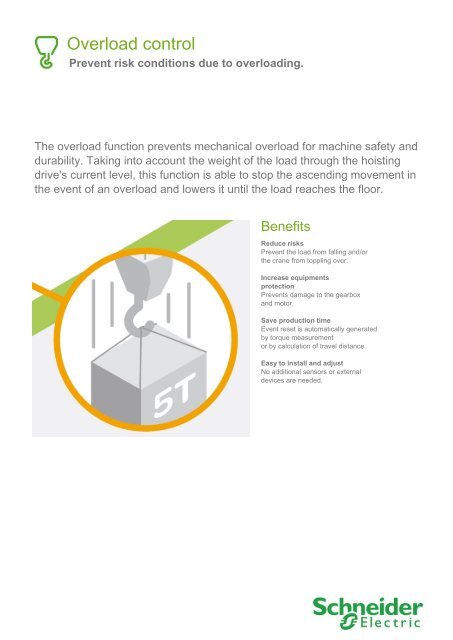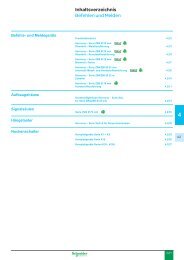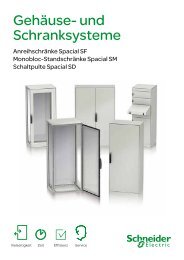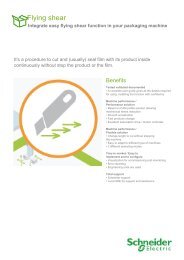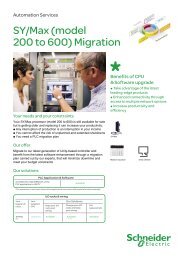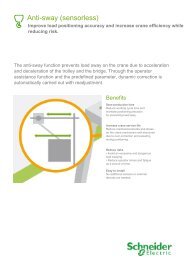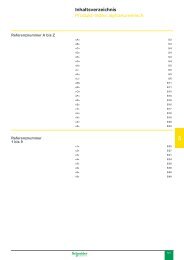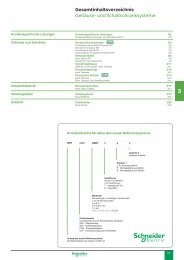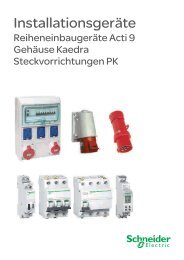Overload control - Schneider Electric
Overload control - Schneider Electric
Overload control - Schneider Electric
You also want an ePaper? Increase the reach of your titles
YUMPU automatically turns print PDFs into web optimized ePapers that Google loves.
<strong>Overload</strong> <strong>control</strong><br />
Prevent risk conditions due to overloading.<br />
The overload function prevents mechanical overload for machine safety and<br />
durability. Taking into account the weight of the load through the hoisting<br />
drive's current level, this function is able to stop the ascending movement in<br />
the event of an overload and lowers it until the load reaches the floor.<br />
Benefits<br />
Reduce risks<br />
Prevent the load from falling and/or<br />
the crane from toppling over.<br />
Increase equipments<br />
protection<br />
Prevents damage to the gearbox<br />
and motor.<br />
Save production time<br />
Event reset is automatically generated<br />
by torque measurement<br />
or by calculation of travel distance.<br />
Easy to install and adjust<br />
No additional sensors or external<br />
devices are needed.
Operating principle<br />
The overload function is based on two<br />
sub-functions: the first detects the<br />
overload and the second resets the alarm.<br />
Each time an upward movement is<br />
started, the overload supervision function<br />
block determines the maximum load limit<br />
that corresponds to an equivalent torque<br />
level in the hoist drive.<br />
When an overload is detected, the<br />
reset function is triggered according to<br />
the selected reset mode using torque<br />
measurement or by calculated travel<br />
distance.<br />
Characteristics<br />
• Up movement is disabled until the<br />
condition is reset<br />
• Error detection using torque<br />
measurement takes into account an<br />
adjustable filter time.<br />
• No sensors or external devices are<br />
needed<br />
• The reset function is automatically<br />
triggered by selecting from one of two<br />
reset modes:<br />
• Torque measurement<br />
or<br />
• Distance travel using an Encoder or<br />
Estimating the distance traveled<br />
Typical<br />
applications<br />
Construction cranes<br />
• Self-erecting cranes<br />
• Tower cranes<br />
Industrial cranes<br />
• Overhead travelling cranes<br />
• Gantry cranes<br />
Typical<br />
architectures<br />
Construction cranes<br />
• Simple hoisting<br />
Compact / Hardwired / Logic<br />
<strong>control</strong>ler / Zelio Logic<br />
• Optimized hoisting<br />
Compact / CANopen / Drive<br />
<strong>control</strong>ler / ATV-IMC<br />
Industrial cranes<br />
• Simple hoisting<br />
Compact / Hardwired / Logic<br />
<strong>control</strong>ler / Zelio Logic<br />
• Optimized hoisting<br />
Compact / CANopen / Drive<br />
<strong>control</strong>ler / ATVIMC<br />
• Optimized hoisting<br />
Compact / CANopen / Logic<br />
<strong>control</strong>ler / M238<br />
<strong>Schneider</strong> <strong>Electric</strong> Industries S.A.S<br />
Head Office<br />
35 rue Joseph Monier<br />
CS 30323<br />
92506 Rueil-Malmaison<br />
www.schneider-electric.com<br />
As standards, specifications and designs change from time to time,<br />
please ask for confirmation of the information given in this publication.<br />
Design : <strong>Schneider</strong> <strong>Electric</strong><br />
Photos : <strong>Schneider</strong> <strong>Electric</strong>


